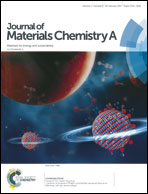Soy protein-based polyethylenimine hydrogel and its high selectivity for copper ion removal in wastewater treatment†
Abstract
The pollution of water resources has become a worldwide concern because of the indiscriminate disposal of heavy metal ions and toxic organics in the past few decades. In this study, we use a sustainable, low cost, and abundant plant protein, soy protein isolate (SPI) as a matrix, polyethyleneimine (PEI) as a functional component to prepare the SPI/PEI composite hydrogels through a facile chemical crosslinking method. The results show that the SPI/PEI composite hydrogels can effectively adsorb Cu(II) ions from aqueous solution. In particular, the SPI/PEI composite hydrogel with a 50% PEI content demonstrates an excellent selectivity for the removal of Cu(II) ions when co-existing competitive heavy metal ions, including Zn(II), Cd(II), and Pb(II), especially the selectivity coefficient for Cu(II)/Zn(II), reaches about 250. Furthermore, the adsorbed Cu(II) ions in the composite hydrogel can be reduced easily in situ by NaBH4 to form uniformly dispersed copper nanoparticles (Cu NPs), which gives a Cu NP-loaded-SPI/PEI composite hydrogel. Such a material is found to be able to act as a catalyst to catalyse the model reaction, i.e., the reduction of 4-nitrophenol with a high efficiency. These results suggest that such a SPI-based hydrogel is a good candidate to selectively adsorb and recycle copper element for the waste disposal industry. In addition, we also provide a strategy to keep the natural resources sustainable, i.e., to select a natural and sustainable material (SPI) to protect the environment (wastewater treatment), and to recycle metals (copper and possibly others).



 Please wait while we load your content...
Please wait while we load your content...